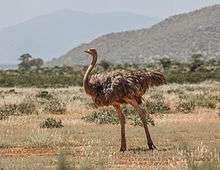Somali ostrich
| Somali ostrich | |
|---|---|
 | |
| Male | |
 | |
| Female | |
| Scientific classification | |
| Kingdom: | Animalia |
| Phylum: | Chordata |
| Class: | Aves |
| Superorder: | Paleognathae |
| Order: | Struthioniformes |
| Family: | Struthionidae |
| Genus: | Struthio |
| Species: | S. molybdophanes |
| Binomial name | |
| Struthio molybdophanes Reichenow, 1883 | |
| Synonyms | |
The Somali ostrich (Struthio molybdophanes) is a large flightless bird native to the Horn of Africa. It was previously considered a subspecies of the common ostrich, but was identified as a distinct species in 2014.[1]
Taxonomy and systematics
Molecular evidence indicates that the East African Rift has served as a geographic barrier to isolate the taxon from the nominate subspecies, the North African ostrich S. c. camelus, while ecological and behavioural differences have kept it genetically distinct from the neighbouring Masai ostrich S. c. massaicus.[2] An examination of the mitochondrial DNA of Struthio taxa, including the extinct Arabian ostrich S. c. syriacus, has found that the Somali ostrich is phylogenetically the most distinct, appearing to have diverged from their common ancestor some 3.6 to 4.1 million years ago.[2][3]
Description
Though generally similar to other ostriches, the skin of the neck and thighs of the Somali ostrich is grey-blue (rather than pinkish), becoming bright blue on the male during the mating season. The neck lacks a typical broad white ring, and the tail feathers are white. The females are slightly larger than the males and browner in plumage than other female ostriches.[4][5]
Distribution and habitat
The Somali ostrich is mostly found in Horn of Africa, especially in north-eastern Ethiopia and across all of Somalia. Its range corresponding roughly to the area known as the Horn of Africa.[4]
Behaviour and ecology
The Somali ostrich is differentiated ecologically from the Common ostrich, with which there is some range overlap, by preferring bushier, more thickly vegetated areas, where it feeds largely by browsing, whereas the latter is mainly a grazer on open savanna. There are also reports of interbreeding difficulties between the two taxa.[2]
Status and conservation
A report to the IUCN in 2006 suggests that the Somali ostrich was common in the central and southern regions of Somalia in the 1970s and 1980s. However, following the political disintegration of that country and the lack of any effective wildlife conservation, its range and numbers there have since been shrinking as a result of uncontrolled hunting for meat, medicinal products and eggs, with the bird facing eradication in the Horn of Africa.[6]
References
| Wikimedia Commons has media related to Struthio molybdophanes. |
| Wikispecies has information related to: Struthio molybdophanes |
- 1 2 BirdLife International (2014). "Struthio molybdophanes". IUCN Red List of Threatened Species. Version 2014.2. International Union for Conservation of Nature. Retrieved 19 June 2012.
- 1 2 3 Freitag, Stephanie & Robinson, Terence J. (1993). "Phylogeographic patterns in mitochondrial DNA of the Ostrich (Struthio camelus)" (PDF). The Auk. 110 (3): 614–622. doi:10.2307/4088425.
- ↑ Robinson, Terence J. & Matthee, Conrad A. (1999). "Molecular genetic relationships of the extinct ostrich, Struthio camelus syriacus: consequences for ostrich introductions into Saudi Arabia". Animal Conservation. 2 (3): 165–171. doi:10.1111/j.1469-1795.1999.tb00062.x.
- 1 2 Shanawany, M.M. & Dingle, John (1999). Ostrich production systems, Part 1. Food and Agriculture Organisation. p. 12. ISBN 978-92-5-104300-4.
- ↑ Roots, Clive (2006). Flightless birds. Greenwood Press. p. 26. ISBN 0-313-33545-1.
- ↑ Amir, Osman G. (2006). Wildlife trade in Somalia (PDF). World Conservation Union – Species Survival Commission. p. 12.
